Let's chat! When’s a good time?




Understanding the impact of marketing efforts on business outcomes has been an important focus area for marketing ever since the beginning. Marketing attribution models have been a lifesaver for businesses in this respect.
With attribution models, it is now possible to identify touchpoints in the customer journey and attribute the credit for the conversion to appropriate marketing channels. Marketers can optimize their approach and focus on the channels and tactics that drive maximum ROI.
However, there are several types of attribution models available. These attribution models provide you with answers to different questions, and depending on what type of question you want to answer, the models change. So you need to know each to understand what works best for your business and use case.
In this blog, you will learn the different types of attribution models with examples and graphs to understand when and how to use each one.
TL;DR:
Attribution models are frameworks that help analyze the customer journey and assign credit to the various touchpoints prior to the conversion. The method for assigning the credit is different for each attribution model depending on either the position of the touchpoint in the customer journey or a data-driven estimation of the significance of that touchpoint.
Additionally, businesses may need to configure these attribution models to suit their unique circumstances - such as considering an attribution window of, say, 60 days or 365 days depending on their sales cycle or performing the attribution analysis at a contact or opportunity, or account level depending on their sales motion.
With the help of these models, marketers are able to identify channels and tactics that drive more conversions and revenue, driving higher ROI for the business.
The following are some of the main reasons why attribution modeling is important.
There are different types of attribution model available for marketers, and we will dive into each in the coming sections.
Before delving into how some of the most popular attribution models work, it’s worth understanding the mechanics of attribution modeling. A general categorization of attribution models would include two types. They are -
These models use predetermined rules for assigning attribution credits to touchpoints. These pre-defined rules determine the weightage or credit for a touchpoint primarily based on its position in the customer journey. Hence, these models are also called Position based Attribution Models.
In addition to the position, you can also define custom logic to assign differential weights based on the seniority of the customer representative involved in the touchpoint (say Director and above gets higher weight) as well as the amount of effort expended by the buyer in that interaction (attending a webinar required higher effort from a buyer than clicking on a paid search ad).
These models assign attribution credits to touchpoints based on an algorithmic estimation of the significance of that touchpoint in converting the customer. Some of the popular algorithmic techniques are Markov Chain models and Shapely value-based models. Whilst data-driven attribution is seen as the north star of Multi-Touch Attribution, they are also more expensive to compute, require a large volume of conversions and touchpoints not to be biased, and are harder to debug.
Whilst each approach has its own pros and cons, a combination of these models may be leveraged to identify marketing leakage and improve ROI.
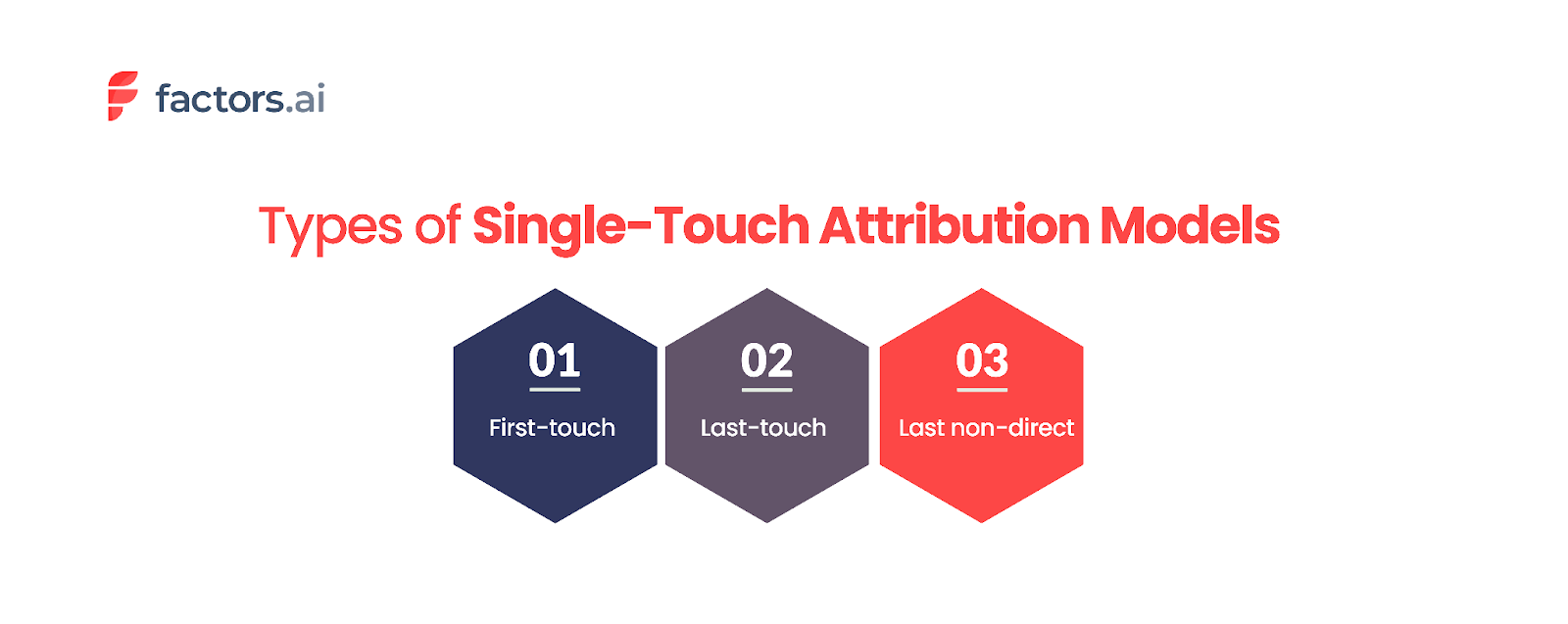
Single-touch attribution, also known as single source attribution, assigns 100% of attribution credit to a single touchpoint (or a single source). While they’re easy to use and interpret, single-touch attribution models may skew your results and affect ROI if used in all situations.
Some of the most common types of single-touch attribution models include:
In this type of attribution model, your customer's first touch-point — whether that be an ad campaign impression, content interaction, or anything else— is deemed the most critical touchpoint in their journey. Hence, this interaction is assigned 100% of the attribution credit.
For instance, let’s assume that you’re in the market for a project management software and come across an advert for one that catches your attention. The ad prompts you to visit the company’s website.
After landing on their “features” page, you follow through with more research and come across the company’s weekly blog — before finally signing up for a demo. In this case, the advert you clicked on is your first impression of the brand and product. Hence, a first-touch attribution model would reward the advert with 100% of the attribution credits.

The First Touch attribution model is most effective in identifying the channels or campaigns that drove your brand's initial awareness amongst your prospects. This would work best for businesses with low sales cycles or a PLG flow, or if you are trying to assess the effectiveness of only Branding Campaigns and Top of the funnel content.
In a normal B2B sales process that stretches over weeks and months, it would be presumptuous to assign 100% of the credit to the very first touchpoint.
In a similar vein to first-touch attribution, a last-touch attribution model assigns 100% of the attribution credits to the touchpoint closest to a customer’s conversion milestone.
This would imply that the last impression made on the customer before their decision to convert was the most prominent in their journey.
Continuing with the previous example of the PMS, the blog piece you come across before scheduling a demo would be the last touch. And so, out of all the touch points that influenced your decision to sign up for a demo, attribution credits will be solely assigned to the final one.
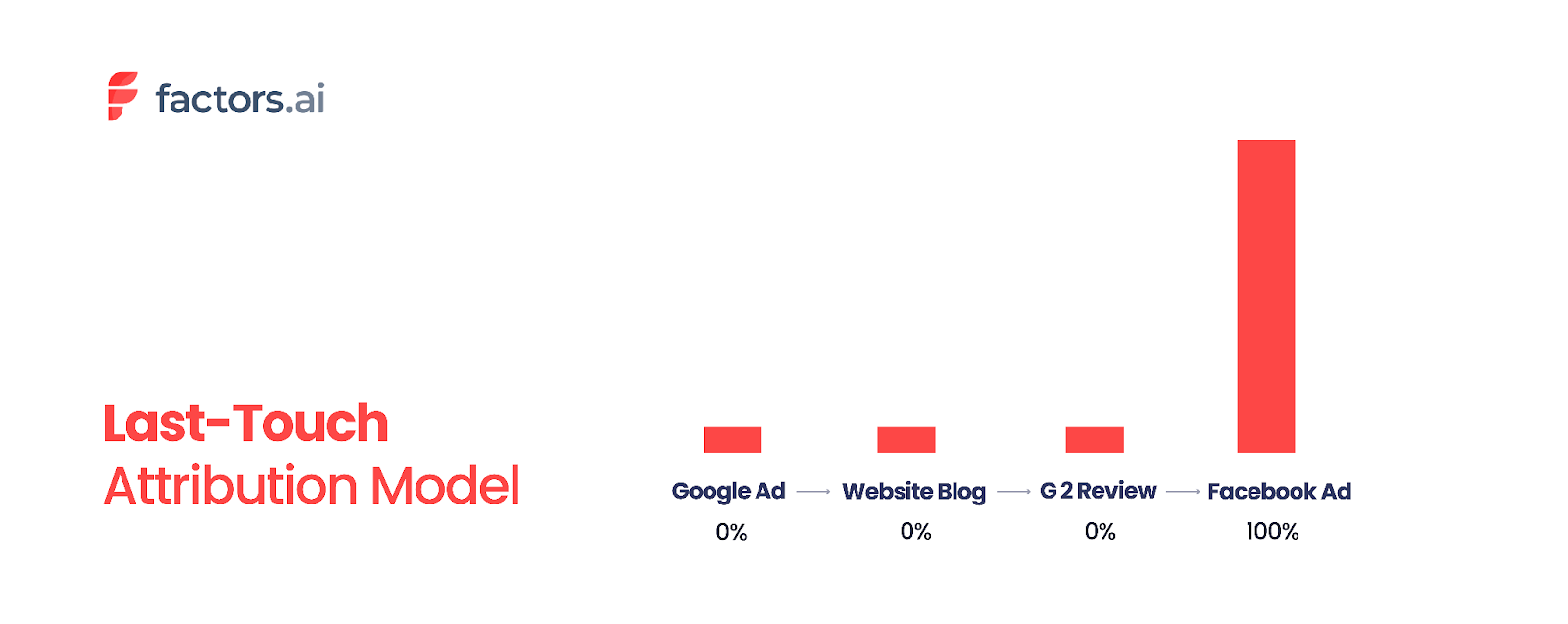
This model assigns 100% attribution credit to the last non-direct touchpoint. A non-direct touchpoint is an interaction that is guided by a specific source the business sets up (like an ad, email campaign, newsletter, etc.).
When your website traffic doesn’t come from a known source, they are considered direct traffic (traffic that came from prospects directly entering the company URL into the browser, for example).
Let’s assume that a lead interacted with your brand 5 times, each touchpoint is as given below.
Touchpoints 1, 2, 3, 4, and 5 constitute all the prospect’s interactions with your brand that led to them purchasing your product. Keep in mind that, in reality, businesses deal with numerous prospects interacting with several touchpoints, making the process of mapping the customer journey far more convoluted.
So if we consider the above-given example, this model would assign 100% sales credit to touchpoint 4 or the newsletter campaign clicked on, as that was the last non-direct source before the sale. This model assumes that every interaction is a consequence of the non-direct campaign, hence making it the most influential.
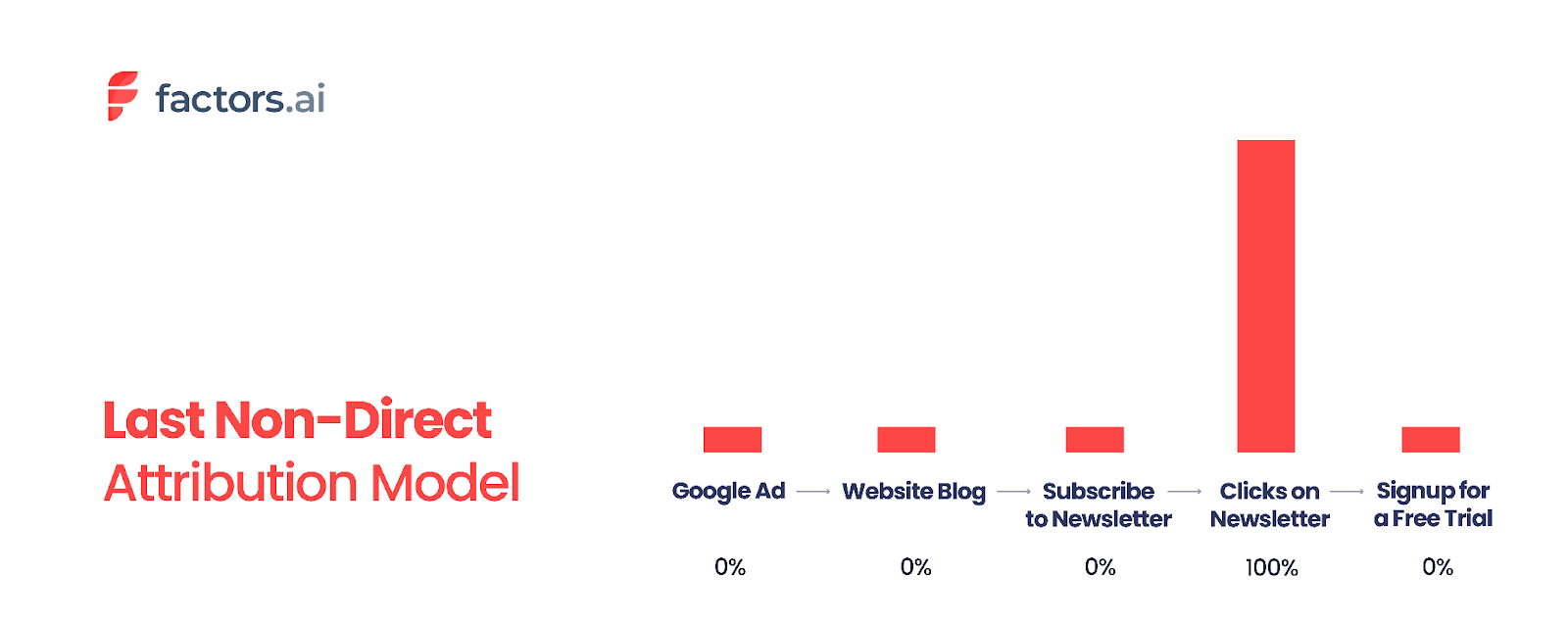
Is Single-Touch attribution an INEFFECTIVE model?
Many businesses and marketing aficionados are of the opinion that single-touch attribution is not an effective model on its own. It is often considered to be a one-dimensional approach that fails to faithfully represent a customer’s conversion journey down the funnel.
As we have discussed, while single-touch models may have their own relevant use cases (like for products with shorter sales cycles), it may not be as effective in identifying the most influential touch-point in a B2B customer journey.
If big data in marketing has proved anything, it's that customer journeys can be non-linear, sophisticated paths spanning several channels and mediums. Assigning 100% of the credit to a single touchpoint will rarely be sufficient.
Multi-touch attribution modeling is the holy grail of marketing attribution. As customers’ buying patterns evolve and become increasingly scattered, a model that can track and account for all these interactions would be more representative of the buying journey.
A multi-touch attribution model accounts for all the touchpoints encountered in a customer’s conversion journey. It’s a holistic view that helps paint a substantially better picture of patterns and behavior than single-touch models.
Remember to keep in mind that the goal of multi-touch attribution isn’t just to map out customers’ interactions. It is also employed to understand which touchpoints influence a customer the most, which touchpoints work in conjunction with each other, and the relative probabilities of channel interactions among different customer paths.
With this established, there is still the issue of assigning credits to many touchpoints. To help illustrate multi-touch attribution better, here are a few of the most commonly used models:
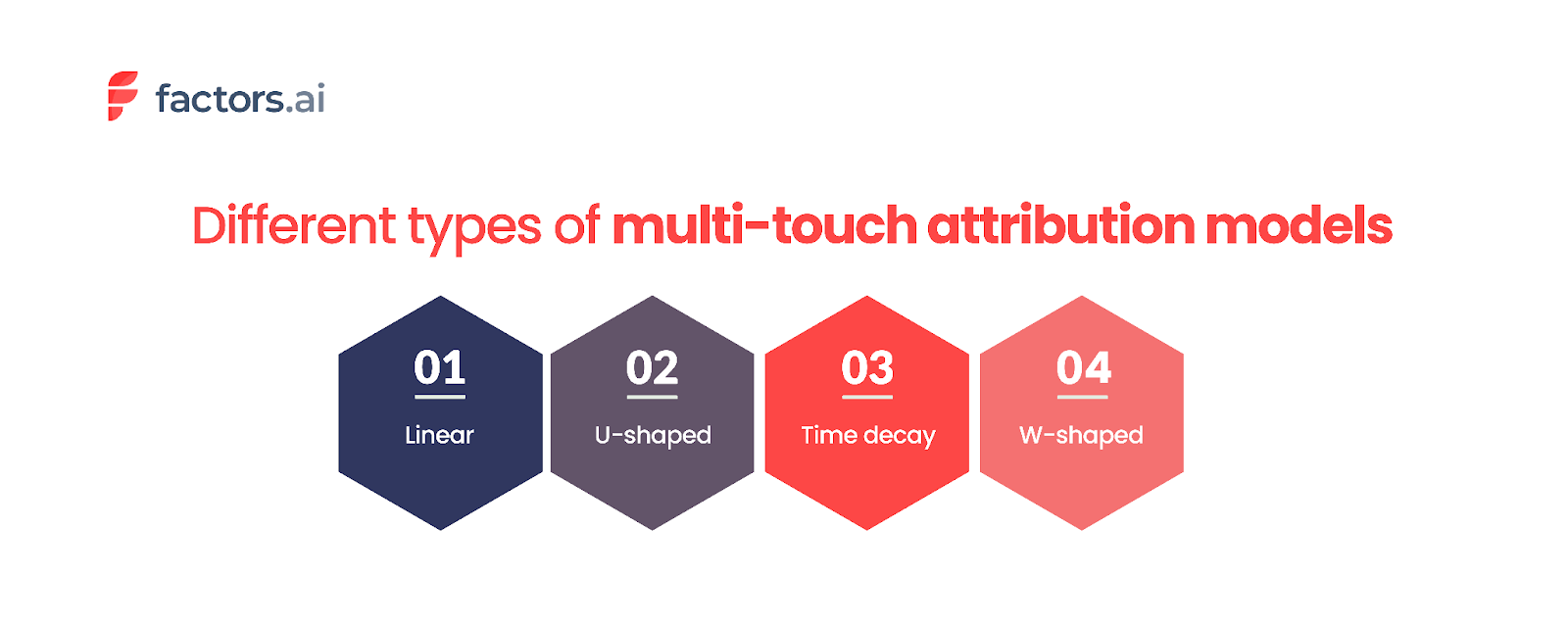
A linear attribution model assigns attribution credits evenly among all touchpoints. While this model is far more illustrative than any of our single-touch attribution options, it's a relatively simplistic approach when compared to its nonlinear variants.
Let’s assume that the total number of touchpoints in our PMS example is four: An advert, a blog, a review, and a retargeting campaign. Linear attribution would reward 25% of attribution credits to each of these touchpoints.
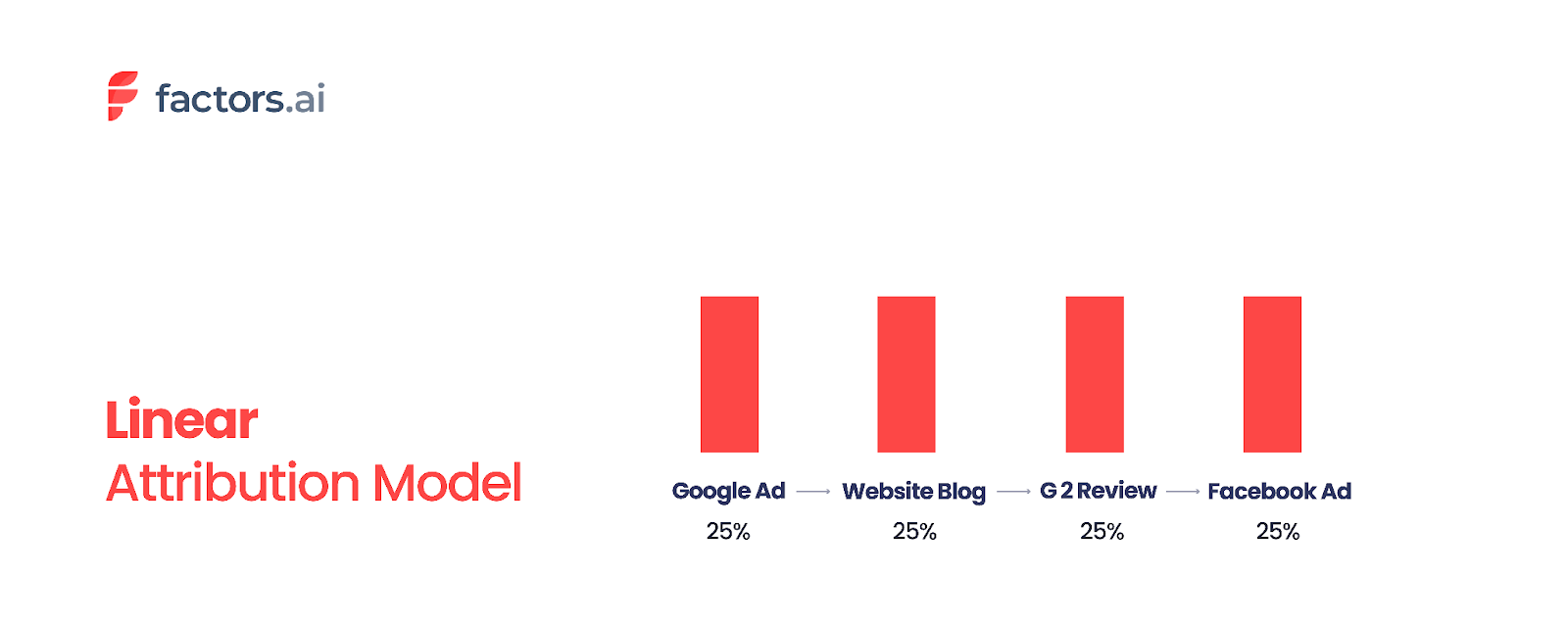
Of course, in reality, the number of touchpoints a B2B customer goes through is significantly higher — so the weights for each one are likely to be far smaller.
The U-shaped model assigns attribution credits to all touchpoints — but assigns higher credits specifically to the first and last touchpoints. This would imply that your customer’s first and last interactions prior to the conversion milestone are the two most valuable touch-points in their journey.
Consider the same four touch points as with the previous example (Ad, Blog, Review, and Retargeting campaign). This time, maybe 40% of the credits will be assigned to the first and last touch points each. The two touchpoints in-between will receive only 10% each as they are deemed less influential to the conversion decision.

The model laid out in a bar graph takes the shape of the letter ‘U’, hence the name.
Time decay attribution assigns attribution credits in an ascending cascade.
What this means is that each touchpoint is given progressively higher credit, with the first touchpoint having the least credit and the last touchpoint having the most. This is an effective tool in mapping out a customer’s conversion journey.
The model works on the assumption that touchpoints closer to the conversion were far more influential than touchpoints further away from the conversion. Again, using our handy four touchpoint PMS example, a time decay model would assign attribution credits in this manner: 5% for the advert, 15% for the blog, 20% for the reviews page, and 60% for the retargeting campaign.
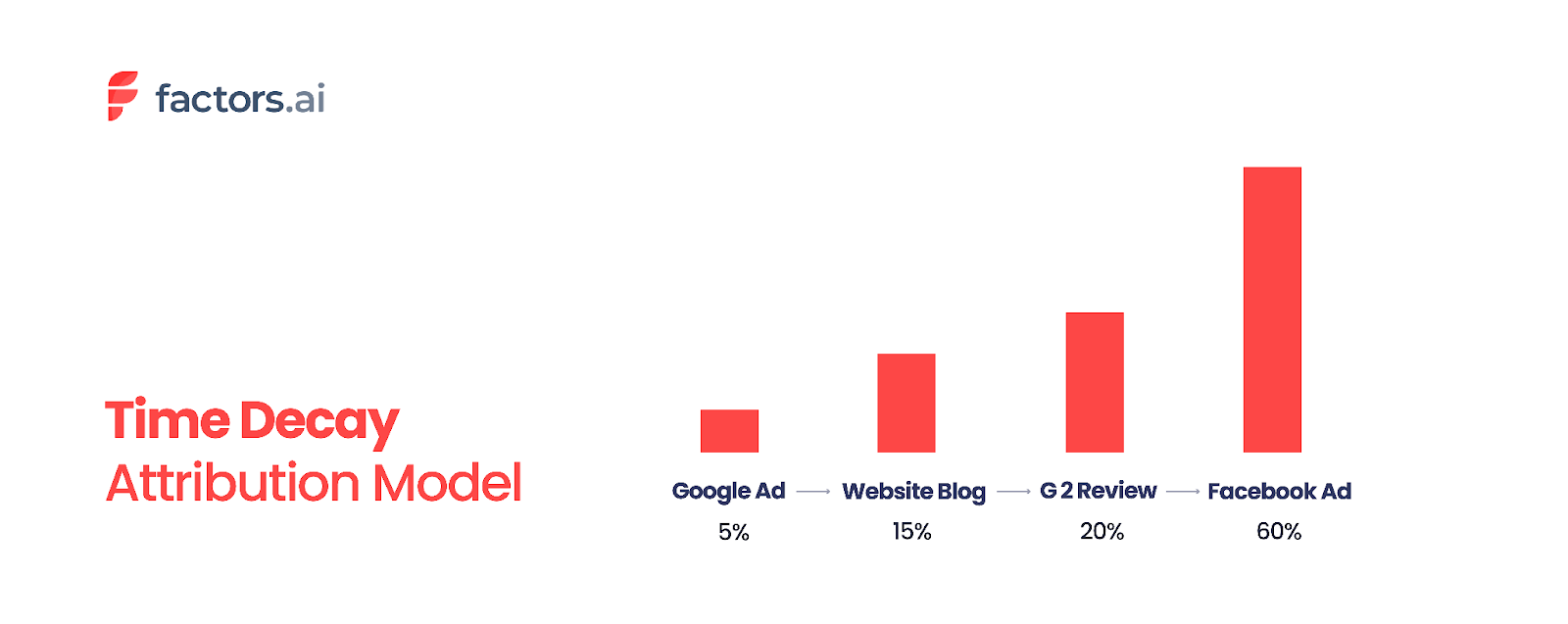
This type of attribution model is similar to the U-shaped model we discussed earlier.
The first and the last touchpoints are also given importance in this model, just as in the U-shaped model. But during the middle of the sales funnel, if you generate quality leads, then that touchpoint is also considered influential. And therefore is given equal importance as that of the first and last touchpoint.
So, if there are 5 first touchpoints in total, the first, middle, and last touchpoints will be given 30% each and the rest only 5%.
To give you a clear-cut idea, take five touchpoints. For example, an advert, a blog, a case study, reviews, and finally, retargeting campaign.
A prospect got in touch with your business through an advertisement, prompted to read your blogs, where they decide to subscribe to your business’s newsletter. Thereby generating a lead towards the middle of the process. The lead then continued to follow up on their research by constantly staying in touch with the business through newsletters. And finally, the lead converts by signing up for a free trial. Following is an example of a graphical representation of the W-shaped attribution model for the given example.
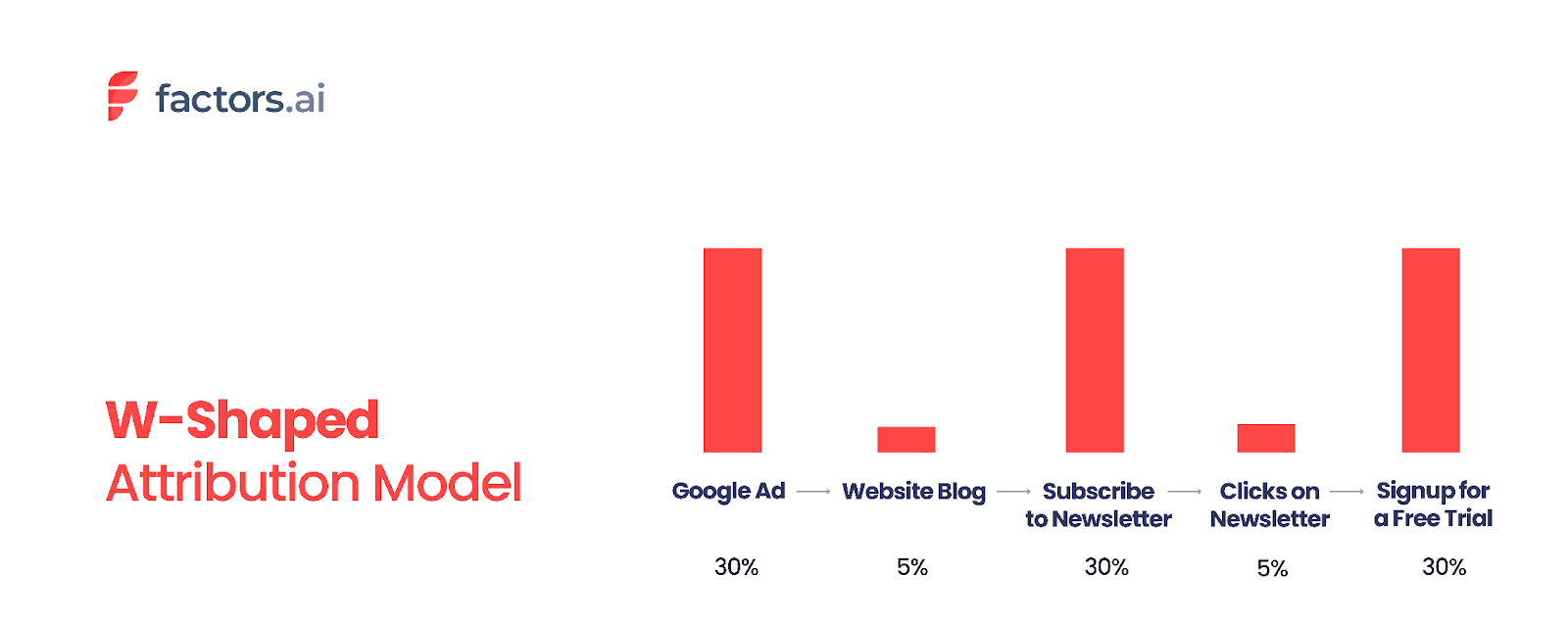
Single-touch attribution models (like first-touch, last-touch, and list non-direct touch) are simple to implement but have several disadvantages. They oversimplify the customer journey by assigning credit to a single touchpoint, ignoring the contributions of other touchpoints. Similarly, these models also neglect the aggregate effect of multiple touchpoints over time. What results is inaccurate credit allocation, because the model disregards individual customer behavior and other factors.
On the other hand, multi-touch attribution models are definitely more complex because they work with complicated algorithms and technology. This often requires expert knowledge and pro- marketing knowledge of marketing software. The impressions from data can be misleading because of shortcomings like wrong assumptions and wrong weightage assigned to each marketing activity. To add on, while multi-touch attribution models are efficient for data- rich digital marketing campaigns, they are not equipped to measure external factors like word-of-mouth, seasonality or pricing.
Like single touch attribution models, multi-touch attribution models can also miss out on giving the full picture. Linear attribution models assume that all touchpoints have equal influence on customer behavior, which is not always the case. U-shaped, W-shaped and Time-Decay models run the risk of oversimplifying the customer journey since they assign more credit only to some touchpoints, while neglecting others. This could cost the model some valuable insights and paint an incomplete picture. The time-decay attribution model considers the recency of the customers close to the conversion event, but it can still overlook the significance of earlier touchpoints.
Needless to say, all attribution models are not appropriate for all use cases. Different attribution models aid different types of marketing campaigns and can reveal different insights into the customer journey.
In the end, a lot of the use cases for these types of attribution models are subjective. The decision to opt for a specific model can be based on several reasons spanning from the nature of your product to the extent of your brand equity. It may also vary based on the specific kind of insight you want to achieve.
More often than not, you will find yourself using more than just one model with several stipulations and custom values for each variant. Fortunately, the progressive ingenuity of AI and constant innovations around attribution modeling will render your experience less of a trial by fire and more of an intuitive, insightful practice.
Leveraging the right marketing analytics platform will be the first step in deciding the attribution model required for your company/business. As we said, it's best to rely on more than one model to improve your desired results. And for that, you will need an expert team, like Factors, that understands your requirements and guides you in leveraging the right techniques.
With Factors.ai, you can easily track the effectiveness of your campaigns and content, identify which channels are driving the most conversions, and optimize your marketing efforts for maximum results. The tool also offers a user-friendly interface and customizable dashboards, making it easy for you to access and interpret your data.
Interested? Sign up here for a FREE trial, or contact our team to get a Free consultation now. Here is the contact email for your reference - solutions@factors.ai
1. How do I choose the right attribution model for my business?
In order to choose the right attribution model, you will need to know the target market, the target audiences, and so on. And once you have everything set, consider the following.
2. How do attribution models help find the gap in the customer journey?
As we discussed earlier in the blog, each attribution model provides insights into your customers' touchpoints with your business. Which itself gives the different paths each customer has taken to reach your service.
Thereby helping you understand the customer journey and find the touchpoints you missed during your initial marketing campaign.
3. How do attribution models help in improving the conversion rate?
Attribution models help improve the conversion rate by identifying which touchpoints in the customer journey are most effective in driving conversions.
They enable data-driven decisions helping businesses optimize their marketing budget and allocate resources efficiently to boost conversion rates.
Get the latest best practices in Marketing Analytics
delivered to your inbox. You don't want to miss this!!